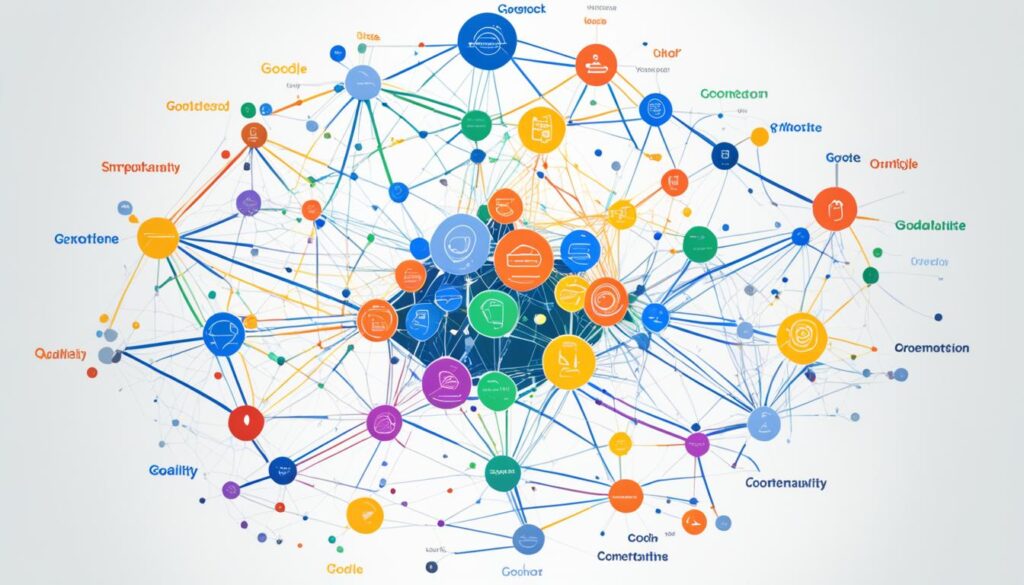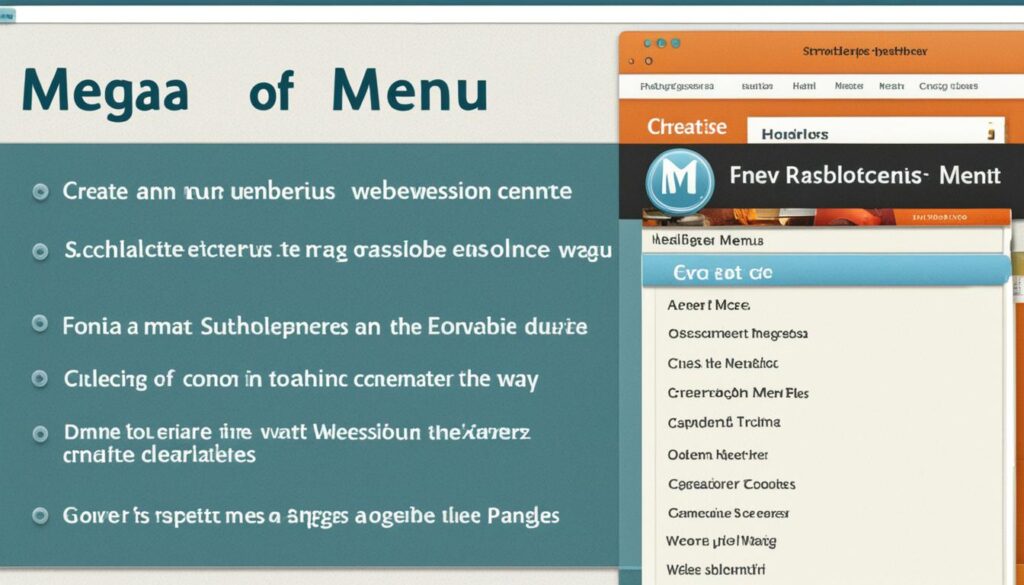Have you heard about the latest **Google updates** that have significantly changed how **websites appear online**? Learn more about these impactful changes and how they can affect you. Keep reading to discover the important details and benefits of staying informed.
In a comprehensive analysis of a 50-site case study, we examined the changes in organic traffic for selected sites between August and December 2023. The results revealed the factors associated with both gains and declines in visibility. By focusing on on-page factors, user experience (UX), and demonstrated expertise, we uncovered valuable insights into the effects of these updates on website rankings.
Key Takeaways:
- Recent Google updates have had a profound impact on website visibility.
- The 50-site case study provides valuable insights into the factors associated with gains and declines in organic traffic.
- On-page factors, user experience, and demonstrated expertise play a significant role in website rankings.
- Combining multiple features seems to have a cumulative effect on Google visibility.
- Site owners should continually adapt and optimize their websites to meet the changing search landscape.
Understanding Google’s Helpful Content Updates (HCU)
Google released a series of updates called Helpful Content Updates (HCU) throughout 2023. These updates had a significant impact on organic traffic for numerous websites. Site owners affected by the HCU were advised by Google to remove unhelpful content as a potential path to recovery. However, determining the precise steps necessary to regain lost traffic can be challenging due to the broad nature of Google’s guidance.
Key Announcements Before the HCU
Prior to the Helpful Content Updates (HCU), Google made several notable announcements that set the stage for these updates. These announcements highlighted the importance of Expertise, Authority, and Trust (E-A-T) and introduced new guidelines for evaluating content quality and user experience. Let’s explore these key announcements:
E-A-T and the Addition of “Experience”
In an effort to provide users with the most relevant and reliable information, Google updated its concept of E-A-T by adding the factor of “Experience.” This addition emphasized the value of demonstrated experience in producing high-quality, trustworthy content. Websites that could showcase their expertise in a particular field or industry were more likely to be rewarded in Google’s rankings.
Updates to Quality Rater Guidelines
Google’s Quality Rater Guidelines underwent significant updates, placing increased emphasis on specific factors that contribute to content quality. These factors include effort, originality, and detailed creator information. Higher ratings from quality raters can positively impact a website’s visibility in search results.
Page Experience Signals
Google also provided guidance on Page Experience signals and their integration into the Helpful Content ranking system. Page Experience signals assess various aspects of user experience, such as page load speed, mobile-friendliness, and the presence of intrusive interstitials. Considering these signals can help site owners optimize their websites for improved visibility and user satisfaction.
These key announcements served as important precursors to the Helpful Content Updates, signaling Google’s intent to prioritize authoritative, high-quality content that offers a positive user experience. The next section will detail the methodology of the 50-site case study that analyzed the impact of these updates.

“The study focused on on-page factors, including elements related to UX and demonstrated expertise.”
| On-Page Factors | Number of Sites (n=50) |
|---|---|
| Page loading speed | 50 |
| Mobile responsiveness | 50 |
| Website structure and navigation | 50 |
| Quality of main content | 50 |
| Use of multimedia | 50 |
| Expertise and authoritativeness | 50 |
The above table outlines the key on-page factors that were thoroughly examined in the case study. Each of these factors was assessed across all 50 sites to identify any correlations with changes in organic traffic. The data collected allowed for a comprehensive analysis of the impact of these factors on website visibility.
Correlations Between Features and Google Visibility
The comprehensive 50-site case study analyzed various on-page features to determine their correlation with changes in Google visibility. The study identified 17 stand-alone features that showed statistically significant correlations with website visibility. These features were associated with either increased visibility or decreased visibility.
Interestingly, no single feature had a 100% correlation with either higher or lower traffic. However, combining multiple features seemed to have additive effects, further influencing website visibility.
For instance, sites that had a combination of a fixed footer ad, scrolling video, and a lack of personal experience had an 83% chance of being in the “losing” group. On the other hand, sites that incorporated first-person pronouns and avoided stock images had an 83% chance of being in the “winning” group.
Correlations with Increased Visibility
- Use of first-person pronouns
- Avoidance of stock images
Correlations with Decreased Visibility
- Fixed footer ad
- Scrolling video
- Lack of personal experience
The study’s findings suggest that certain combinations of features can significantly impact a website’s visibility on Google. It highlights the importance of optimizing on-page elements to align with Google’s preferences and improve search rankings.
| Winning Group | Sites that used first-person pronouns and avoided stock images |
|---|---|
| Losing Group | Sites that had a fixed footer ad, scrolling video, and lacked personal experience |

Negative Correlated Features
When analyzing the impact of Google updates on website visibility, several features have shown a negative correlation. These features, when present on a page, are associated with decreased visibility in Google’s search results.
One such feature is footer ads that scroll with the user. These ads, which often appear at the bottom of a webpage, follow the user as they scroll, potentially causing a distraction and detracting from the overall user experience.
Another negatively correlated feature is auto-play video ads that cover significant content. These ads automatically start playing when a user visits a webpage and can obscure essential information, leading to a poor user experience and lower visibility on Google.
The use of stock images or images not from the original source is also negatively correlated with visibility. Google values original and high-quality content, and the inclusion of stock images or unrelated images can signal a lack of authenticity and diminish the page’s visibility.
Lastly, the presence of video and image ads on a page has been found to have a negative correlation with visibility. While advertisements are a common way for websites to generate revenue, an excessive amount of video and image ads can impact the user experience and lower the page’s visibility in search results.
To visually summarize the negative correlated features:
| Negative Correlated Features |
|---|
| Footer ads that scroll with the user |
| Auto-play video ads that cover significant content |
| Use of stock images or images not from the original source |
| Presence of video and image ads on the page |
By avoiding these negatively correlated features, website owners can improve their visibility in Google search results and enhance their overall user experience. Let’s now explore the features that have shown a positive correlation with visibility in the next section.

Positive Correlated Features
When analyzing the impact of Google updates on website visibility, certain features showed a positive correlation. These findings provide valuable insights for site owners looking to improve their Google rankings.
Use of First-Person Pronouns
The inclusion of first-person pronouns in the main content was found to have a positive correlation with Google visibility. By using words like “I,” “me,” and “my,” website owners can establish a personal connection with their audience. This personal touch indicates expertise or experience, making the content more relatable and trustworthy.
First-Hand Experience Demonstration
In addition to first-person pronouns, demonstrating first-hand experience with the content was also positively correlated with Google visibility. Site owners who share their own experiences, insights, or expertise create valuable and authentic content that resonates with readers. This not only helps build credibility but also enhances the overall user experience.

Presence of a Cookie Consent Banner
Interestingly, the presence of a cookie consent banner was also found to be positively correlated with visibility on Google. While the exact reason for this correlation remains unclear, it’s possible that displaying a cookie consent banner indicates compliance with privacy regulations and enhances user trust. This may lead to a more favorable perception by search engines.
Overall, incorporating these positive correlated features can potentially boost website visibility on Google and improve overall search rankings.
Impact of Browser Push Notifications and Mega Menus
The impact of certain website features on Google visibility has been a key focus of the 50-site case study analysis. Two notable features, browser push notifications and mega menus, have shown correlations with changes in website visibility.
Sites utilizing browser push notifications experienced a decrease in visibility on Google search results. This suggests that the frequent and potentially intrusive nature of push notifications may have a negative impact on user experience and site performance.
On the other hand, sites implementing mega menus, which are large navigational menus positioned at the top of the website with numerous links, were more likely to be associated with decreased visibility. This indicates that the presence of mega menus may lead to a cluttered user interface, making it difficult for search engines to crawl and understand the site’s content.
It is important for site owners and web developers to carefully consider the implications of using browser push notifications and mega menus. While these features can offer added functionality and navigation options, they should be implemented thoughtfully to ensure they do not hinder website visibility on search engines.

Caveats and Disclaimers
When interpreting the findings of the case study, it is important to acknowledge the limitations of the research. The sample size of the study was relatively small, consisting of 50 selected sites. While the study provides valuable insights into the potential impact of certain features on Google visibility, it is essential to consider the context in which these findings were obtained.
The identified features are not direct ranking factors but rather associations with winning or losing sites. This means that implementing or removing these features does not guarantee success or failure in Google rankings. Keep in mind that correlation does not imply causation.
“Correlation does not imply causation” – a phrase often emphasized within research and data analysis. This principle reminds us not to hastily attribute causality to observed patterns or relationships. It is essential to recognize that the presence or absence of specific features does not directly cause the rise or decline in Google visibility.
Understanding the association between features and website visibility is a complex process, and there may be other factors at play that have not been considered in this case study. Therefore, it is crucial to approach the findings with caution and evaluate them in conjunction with other relevant metrics and industry best practices.
That being said, the case study provides insights that can guide website owners in making informed decisions about their online presence and potential areas for improvement. By analyzing the correlations observed in the study, site owners can assess their own websites and explore strategies to enhance their visibility in search engine results.
Please keep in mind that every website is unique, and the impact of specific features may vary based on various factors, including industry, target audience, and overall website structure. Consider these insights as a starting point and adapt them to your specific situation and goals.
Conclusion
The 50-site case study analyzing the impact of Google updates has provided valuable insights into the associations between specific on-page features and changes in Google visibility. Although no single feature can guarantee success or failure, the study revealed that combining multiple features can have a cumulative effect on website performance.
Website owners can capitalize on these findings by evaluating their own sites and identifying potential areas for improvement. By implementing the features that have shown a positive correlation with winning sites, such as the use of first-person pronouns and demonstrating first-hand experience, site owners can enhance their chances of achieving better Google visibility.
This case study underscores the complex nature of Google updates and emphasizes the importance of continuously adapting to the evolving search landscape. To maintain a competitive edge, site owners must stay abreast of the latest updates, align their strategies with Google’s quality guidelines, and regularly assess their sites to ensure they meet the ever-changing criteria for success.
By leveraging the insights gained from this robust case study, website owners can maximize their chances of success in the face of Google updates, positioning their sites as winning contenders in the highly competitive online landscape.
FAQ
What does the 50-site study analyze?
The 50-site study analyzes the impact of recent Google updates on organic traffic and website visibility.
What are Google’s Helpful Content Updates (HCU)?
Google’s Helpful Content Updates (HCU) are a series of updates that have caused significant changes in organic traffic for many sites.
How does Google recommend site owners recover from the impact of HCU?
Google advises site owners impacted by HCU to remove unhelpful content as a potential path to recovery.
What were the key announcements made by Google before the HCU?
Before the HCU, Google made announcements regarding the addition of “Experience” to Expertise, Authority, and Trust (E-A-T), updates to the Quality Rater Guidelines, and guidance on Page Experience signals.
How was the 50-site case study conducted?
The 50-site case study evaluated changes in organic traffic for selected sites between August and December 2023, focusing on on-page factors, user experience (UX), and demonstrated expertise. Over 2,500 data points were collected for each site.
What features showed a negative correlation with Google visibility?
Features such as scrolling footer ads, auto-play video ads that cover important content, the use of stock images or images from non-original sources, and video and image ads on the page showed a negative correlation with Google visibility.
What features showed a positive correlation with Google visibility?
The use of first-person pronouns in the main content, indications of personal expertise or experience, first-hand experience with the content, and the presence of a cookie consent banner showed a positive correlation with Google visibility.
How do browser push notifications and mega menus impact Google visibility?
Browser push notifications were associated with decreased visibility, while sites using mega menus, large navigational menus at the top of the website, were more likely to be in the “losing” group.
What are the limitations of the case study?
The case study had a relatively small sample size, and the identified features are associations rather than ranking factors. Correlation does not imply causation.
How can site owners use the insights from the case study?
Site owners can use the insights from the case study to evaluate their own sites and consider areas for improvement in order to adapt to changes in the search landscape.









